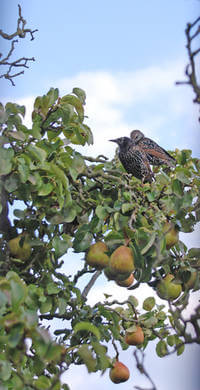Starlings, and blackbirds are often confused. In this article, we first explain how to distinguish them, and then recommend the best solutions for effectively repelling starlings and blackbirds when they are a problem.
First, how to tell Starlings apart from Blackbirds
As we can see in the following images starlings, and blackbirds have some physical differences:
- the photo on the left is of a male blackbird, while
- the photo on the right is of a starling.
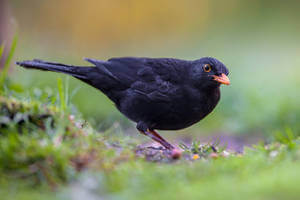
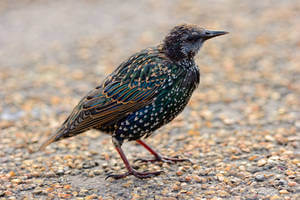
In addition to the physical differences, there are also differences in their way of life. While starlings live and fly in flocks, blackbirds are less sociable birds and we see them alone or in pairs.
About Blackbirds

The Latin name for Blackbirds is Turdus Merula. Male blackbirds live up to their English name, as they have black plumage. However, females have brown plumage with spots and stripes on their chests.
Blackbirds have a bright orange-yellow beak. They have striking eyes and a soft song. These three characteristics make adult male blackbirds one of the most eye-catching birds in our gardens.
The blackbird is a resident bird in Spain. This means that they can be seen throughout the year. Blackbirds primarily feed on insects, worms, and berries or small fruits.
About Starlings

The Latin name for Starlings is Sturnus Vulgaris.
Starlings are smaller than blackbirds. They have a short tail, pointed head, and triangular wings. When viewed from a distance, starlings appear black. However, if we get closer, we will see that they have shiny plumage with a combination of blues, purples, and greens, as we can see in the photograph.
Starlings have a fast and direct flight. They are also able to run and walk confidently on the ground.
Starlings are very noisy birds. In addition, they are gregarious birds, meaning they live in large groups or flocks for much of the year. As we can see in the following video, watching a flock of starlings is an incredible spectacle.
The flock of starlings moves as a whole, contracting and expanding, rising, descending, and changing direction while always maintaining a compact shape. Unlike other flocks of birds, in a flock of starlings, there is no leader that everyone follows; each starling moves based on the movements of its closest neighbors, regardless of the size of the flock.
Starlings mainly feed on insects, fruits, berries, and seeds.
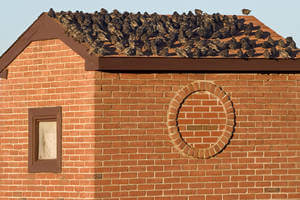
Starlings nest in holes, hollows, or cavities in virtually any location: trees, birdhouses, buildings, etc… Females lay 4 to 7 eggs. The chicks hatch after 11 to 13 days of incubation and leave the nest after 21 days. Both the male and the female are responsible for building the nest, incubating the eggs, and feeding their chicks. Sometimes starlings have 2 broods per season.
Once the breeding season is over, starlings live in large flocks. They usually choose large trees to perch on so that the entire flock can stay together, although on occasion, as we see in the photo, they choose buildings or farms, barns,…
Starling Infestations
The main problem with starlings is that they are gregarious birds, living in HUGE flocks. A single flock of starlings can reach tens of thousands of individuals.
Problems with Starlings: Structural Issues
A flock of starlings leaves a large amount of dirt in its wake, produced by the birds’ droppings. In addition to the hygienic and sanitary risks, it can cause structural problems since the uric acid found in the droppings can corrode stone, metal, and other materials.
Hygienic and Sanitary Risks Caused by Starlings
The droppings of starlings contain bacteria and fungi responsible for serious diseases such as histoplasmosis, encephalitis, salmonella, meningitis, and toxoplasmosis, among others.
Problems of Starlings for Agriculture, Livestock, Golf Courses…
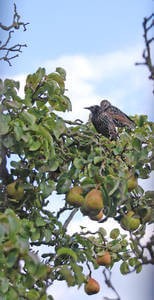
As we mentioned, starlings feed on insects, seeds, and fruits. The huge flocks of starlings are a pest and a serious problem for agriculture. Starlings cause severe damage to crops, damaging vineyards and fruit fields of peaches, blueberries, strawberries, figs, apples, pears, cherries, vineyards, … And also eating the seeds planted in the fall.
In farms and livestock operations, such as cattle, pigs, sheep, or poultry farms, starlings selectively feed on the animals’ feed, causing significant economic losses. In addition, they can transmit diseases to livestock.
Similarly, starlings sometimes damage the turf of golf courses, pecking at it in search of insects and larvae.
Effective Methods to Repel Starlings
The most effective solution for repelling starlings and blackbirds is the BirdGard Pro #61 Repeller, which operates using audible sounds. This repeller covers up to 6,000 m2. If you need larger coverage, there are other more powerful starling and blackbird repellers available:
- BirdGard Pro Plus #61 for starlings, and blackbirds – covers up to 12,000 m2. That is: 1.2 hectares
- Starling and Blackbird Repeller BirdGard Super Pro #61 – covers up to 24,000 m2. That is: 2.4 hectares
- BirdGard Super Pro Amp #61 for starlings, and blackbirds – covers up to 120,000 m2- That is: 12 hectares
All these bioacoustic repellers for starlings and blackbirds have the following characteristics:
- Weather-resistant. They are specially designed for outdoor use.
- The sounds of the Bird GardStarling, and Blackbird Repellers do not affect livestock or pets. Domestic animals and livestock quickly become accustomed to the sounds of the Bird Gard starling and blackbird repeller and are not affected by them.
- They come with a 30-day money-back guarantee if you are not satisfied with the results obtained. We have many years of experience with these devices and know that they are very effective. This money-back guarantee is a way to convey that confidence to you.
- Very easy installation. You can do it yourself. No specialist technician is required.
- Fully programmable, with volume settings, sound combinations, and day, night, or 24-hour operation modes. They include different functions that randomly vary the sound, the duration of the sound, and the time interval between sounds.
- Blackbirds and starlings do not become accustomed to the sounds. You can use the device continuously, year after year. The sounds are emitted randomly and in a completely unpredictable pattern.
- They are completely environmentally friendly and bird-friendly. Bird Gard starling and blackbird repellers repel bird pests economically and effectively without harming the birds or the environment in a natural way.
Sound to Repel Starlings and Blackbirds
The #61 chip is specifically designed to repel starlings and blackbirds. It contains a combination of 8 different sounds that include distress calls from these birds and predator sounds. When the starlings, and blackbirds hear them, they believe there is danger and immediately move away from the area.
The 8 sounds of the #61 chip to repel starlings and blackbirds are:
- European Starling (Sturnus Vulgaris) – Distress call of the Starling
- European Starling (Sturnus Vulgaris EURO) – Distress call of the Starling
- Eurasian Blackbird (Turdus merula) – Distress call of the Blackbird
- American Robin (Turdus migratorius) – Distress call of the Spring Blackbird
- House Sparrow (Passer domesticus) – Distress call of the Sparrow
- European Hobby (Falco subbuteo) – Predator sound – Falcon
- Sparrowhawk (Accipiter nisus) – Predator sound – Sparrowhawk
- Eurasian Buzzard (Buteo buteo) – Predator sound – Common Buzzard
In this video, you can listen to the eight sounds of the #61 chip for repelling starlings and blackbirds.
How to Repel Starlings, Blackbirds – Additional Information
If you have any questions about which Bird Gard repeller is most suitable for repelling starlings and blackbirds, you can consult the article, “I have problems with birds, but which repeller do I need?“.
Below we list some references from BirdGard Iberia customers who use BirdGard bird repellers to repel flocks of starlings, and blackbirds:
- Bird Repellers used to minimize power outages caused by starling flocks on power lines. Reference: Iberdrola
- Experience of one of BirdGard Iberia’s clients with the bioacoustic repeller Bird Gard Pro, for getting rid of starlings at their tourist complex in Mahón.
- See other Customer References from BirdGard Iberia
Or if you prefer, you can contact BirdGard Iberia and one of our technicians will advise you on the most suitable solution for repelling starlings and blackbirds in your specific case.
